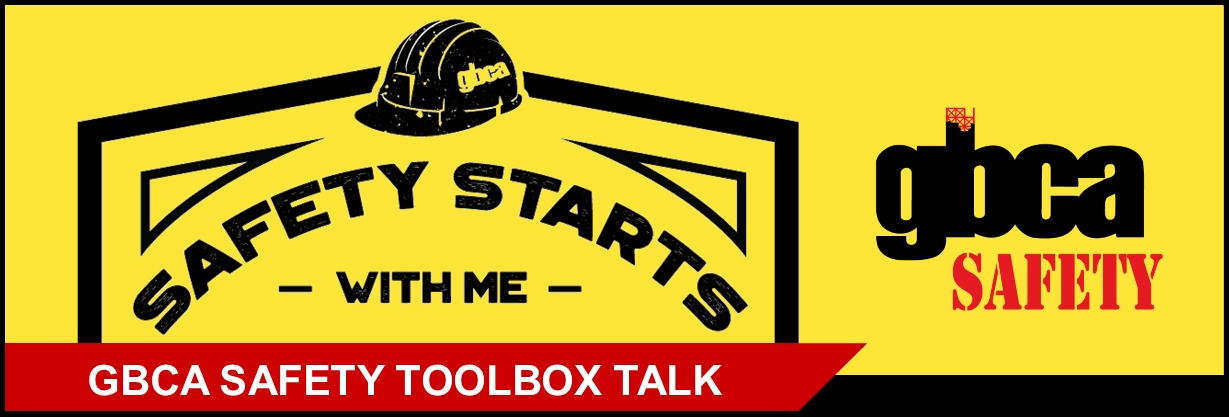This GBCA Toolbox Talk discusses verbal de-escalation techniques for defusing or talking down an explosive situation. Click below to download the Toolbox Talk as a handout (includes Sign-In Sheet).
Verbal De-Escalation Techniques
Conflict resolution on the jobsite is not limited to conflicts between workers. Members of the public may attempt to engage with jobsite workers. We want to avoid violence on the jobsite. This toolbox talk looks at verbal de-escalation techniques for defusing or talking down an explosive situation.
When a potentially verbally and/or physically explosive situation occurs, and no weapon is present, verbal de-escalation is appropriate and needed.
Remember, there is nothing magic about calming a very angry or agitated person.
Most often, the person wants to be heard. Inverbal de-escalation, you are conveying a sense of genuine interest in what the person wants to tell you, of calmness, and of respectful, clear limits. Hopefully the person will respond positively to your respectful attention.
There are two important concepts to keep in mind:
- Reasoning logically with a very angry person is not possible. The first and only objective in de-escalation is to reduce the level of anger so that discussion becomes possible.
- De-escalation techniques do not come naturally. We are driven to fight, flight or freeze when confronted by a very angry person. However, in de-escalation, we can do none of these. We must appear centered and calm.
There are three parts to be mastered in verbal de-escalation:
A: THE PERSON IN CONTROL OF HIM/HERSELF
- Appear calm, centered, and self-assured even though you do not feel it. Relax facial muscles and look confident.
- Use a modulated, low monotonous tone of voice (our normal tendency is to have a high pitched, tight voice when scared).
- Do not be defensive, even if the comments or insults are directed at you. They are not really about you personally. Do not defend yourself or anyone else from insults, curses, or misconceptions about their roles.
- Be very respectful even when firmly setting limits or calling for help. The agitated individual is very sensitive to feeling shamed and disrespected. We treat them with dignity and respect.
B: THE PHYSICAL STANCE
- Never turn your back for any reason.
- Always be at the same eye level.
- Allow extra physical space between you and the angry person, about four times your usual distance. Anger and agitation fill the extra space between you and the person.
- Do not stand full front to person. Stand at an angle so you can sidestep away if needed.
- Do not maintain constant eye contact. Allow the person to break his/her gaze and look away.
- Do not point or shake your finger.
- DO NOT smile. This could look like mockery or anxiety.
- Keep hands out of your pockets, up and available to protect yourself.
C: THE DE-ESCALATION DISCUSSION
- Remember that there is no content except trying to calmly bring the level of anger down to a safer place.
- Do not get loud or try to yell over a screaming person. Wait until he/she takes a breath; then talk. Speak calmly at an average volume.
- Do not solicit how a person is feeling or
- interpret feelings in an analytic way.
- Do not argue or try to convince.
- Do not be defensive or judgmental.
- Give choices, when possible, that set the limits of the types of permitted engagement in which both alternatives are safe ones.
- For example, “Would you like to continue our meeting calmly or would you prefer to stop now and come back tomorrow when things can be more relaxed?”
- Trust your instincts. If you assess or feel that de-escalation is not working, STOP! You will know within 2 or 3 minutes if it is beginning to work.
This toolbox talk is based on the following training materials:
Verbal De-Escalation Techniques for Defusing or Talking Down an Explosive Situation
Author: Eva Skolnik-Acker, LICSW Committee for the Study and Prevention of Violence Against Social Workers, National Association of Social Workers, Massachusetts Chapter.
Remember to record the attendees of your toolbox talk!
Access GBCA’s full library of toolbox talks:





